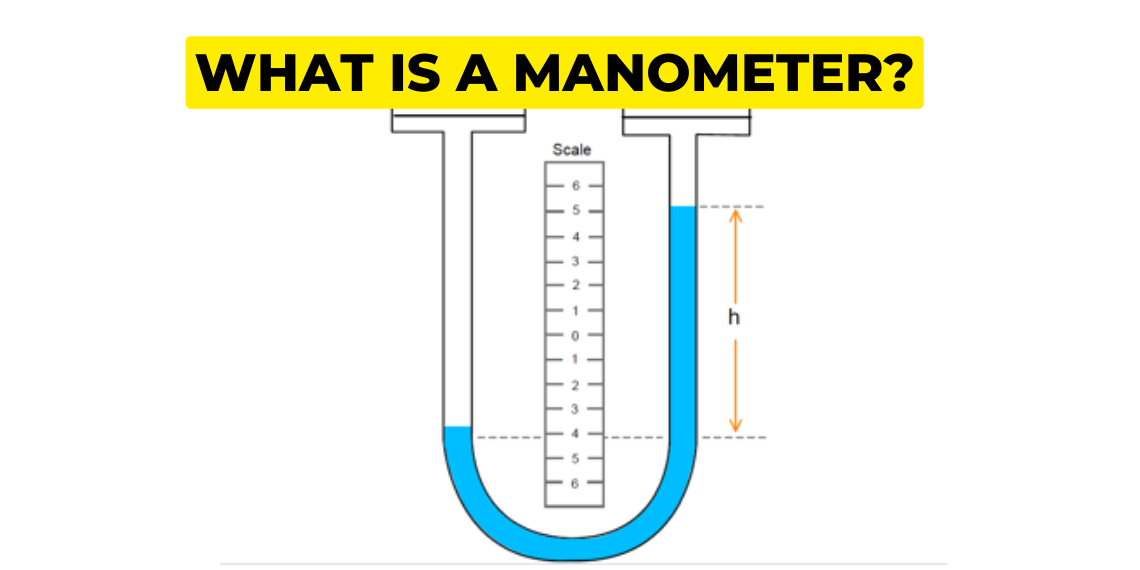What is a Manometer? | Use of Manometer in ship
Manometer is a pressure measuring device using liquid columns in vertical tubes. It is used to measure the fluid pressure w.r.t an outside source which is considered to be earth’s atmosphere. It is basically used to measure air pressure.

It is a U shaped tube which has water in it which is used to measure pressure difference with its two arms causing the liquid to move to different heights with difference in pressure. It can also be used when it is not possible to use a pressure gauge in any specific area.

Why and where is it required on the ship?
On a ship, a manometer can be used in several applications such as:
Main engine air cooler:
Air Cooler cools the hot compressed air from Turbocharger. Thereby, lowering the air temperature and increasing its density. More density means more mass of air supplied, increasing the efficiency of the engine. Turbochargers provide fresh air to the engine that may sometimes block the fins in the air cooler, resulting in a loss of cooling efficiency and improper combustion in the main engine. We use a manometer attached to both sides of the cooler to determine the condition of the cooler.

Main engine turbocharger felt filter:
A turbocharger felt filter is a type of air filter used in turbocharger systems to protect the turbocharger from damage caused by debris and other contaminants in the air. Over time, these contaminants can accumulate on the surface of the filter, causing a pressure drop that can affect the turbocharger’s performance.
Using a Manometer to measure the pressure drop across the felt filter, it is possible to determine when the filter needs to be replaced or cleaned. One point of the manometer is placed outside the turbocharger and the other is placed inside the turbocharger. When air is sucked in there is a vacuum inside it so the pressure on the manometer leg outside has higher pressure due to atmospheric pressure and we will get the pressure difference.

How do we interpret manometer readings on a ship?
Manometer pressure on a turbocharger depends upon one major factor:
Load on the main engine:
The load on the main engine refers to the amount of power the engine is producing, which is directly related to the amount of fuel being burnt in the engine. The main engine load can be affected by various factors such as the ship’s speed, sea conditions, and the demand for power. When the main engine is running at a higher RPM, more fuel is burnt, and more exhaust gas is produced. This exhaust gas drives the main engine turbocharger turbine faster, which increases the main engine turbocharger RPM. The increase in the main engine turbocharger RPM causes the turbocharger to suck in more air and compress the air further, which increases the scavenge air pressure.
As a result, more air passes through the air cooler, causing an increase in pressure drops across the air cooler. This increase in pressure drop causes the manometer reading to increase. Additionally, the increase in the main engine RPM causes the turbocharger blower RPM to increase, which produces more vacuum inside the silencer region. This, once again, causes the manometer reading to increase. Conversely, when the main engine RPM is significantly less, the pressure drops across the air cooler’s airside are reduced. Thus, the main engine load and RPM are interdependent on each other, and the increase in one will cause an increase in the other.
Let us formulate a chart for better understanding:
- Let us take an example of a Main engine Turbocharger.

2. Now let us take an example of a Main engine air cooler.

Note:
If you want to learn more about this topic, we suggest checking out our Combo package with the given link https://merchantnavydecoded.com/courses/c/ . It’s a great way to dive deeper into the subject through video explanations. This package covers all the important details and presents them in an easy-to-understand format. Watching the videos will help you grasp the topic better and make learning more enjoyable. So, we highly recommend giving our Combo package a try to enhance your knowledge on the subject.
Disclaimer :- The opinions expressed in this article belong solely to the author and may not necessarily reflect those of Merchant Navy Decoded. We cannot guarantee the accuracy of the information provided and disclaim any responsibility for it. Data and visuals used are sourced from publicly available information and may not be authenticated by any regulatory body. Reviews and comments appearing on our blogs represent the opinions of individuals and do not necessarily reflect the views of Merchant Navy Decoded. We are not responsible for any loss or damage resulting from reliance on these reviews or comments.
Reproduction, copying, sharing, or use of the article or images in any form is strictly prohibited without prior permission from both the author and Merchant Navy Decoded.


